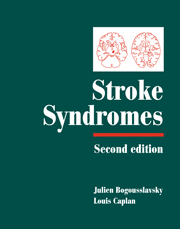Book contents
- Frontmatter
- Contents
- List of contributors
- Preface
- PART I CLINICAL MANIFESTATIONS
- PART II VASCULAR TOPOGRAPHIC SYNDROMES
- 29 Arterial territories of human brain
- 30 Superficial middle cerebral artery syndromes
- 31 Lenticulostriate arteries
- 32 Anterior cerebral artery
- 33 Anterior choroidal artery territory infarcts
- 34 Thalamic infarcts and hemorrhages
- 35 Caudate infarcts and hemorrhages
- 36 Posterior cerebral artery
- 37 Large and panhemispheric infarcts
- 38 Multiple, multilevel and bihemispheric infarcts
- 39 Midbrain infarcts
- 40 Pontine infarcts and hemorrhages
- 41 Medullary infarcts and hemorrhages
- 42 Cerebellar stroke syndromes
- 43 Extended infarcts in the posterior circulation (brainstem/cerebellum)
- 44 Border zone infarcts
- 45 Classical lacunar syndromes
- 46 Putaminal hemorrhages
- 47 Lobar hemorrhages
- 48 Intraventricular hemorrhages
- 49 Subarachnoid hemorrhage syndromes
- 50 Brain venous thrombosis syndromes
- 51 Carotid occlusion syndromes
- 52 Cervical artery dissection syndromes
- 53 Syndromes related to large artery thromboembolism within the vertebrobasilar system
- 54 Spinal stroke syndromes
- Index
- Plate section
43 - Extended infarcts in the posterior circulation (brainstem/cerebellum)
from PART II - VASCULAR TOPOGRAPHIC SYNDROMES
Published online by Cambridge University Press: 17 May 2010
- Frontmatter
- Contents
- List of contributors
- Preface
- PART I CLINICAL MANIFESTATIONS
- PART II VASCULAR TOPOGRAPHIC SYNDROMES
- 29 Arterial territories of human brain
- 30 Superficial middle cerebral artery syndromes
- 31 Lenticulostriate arteries
- 32 Anterior cerebral artery
- 33 Anterior choroidal artery territory infarcts
- 34 Thalamic infarcts and hemorrhages
- 35 Caudate infarcts and hemorrhages
- 36 Posterior cerebral artery
- 37 Large and panhemispheric infarcts
- 38 Multiple, multilevel and bihemispheric infarcts
- 39 Midbrain infarcts
- 40 Pontine infarcts and hemorrhages
- 41 Medullary infarcts and hemorrhages
- 42 Cerebellar stroke syndromes
- 43 Extended infarcts in the posterior circulation (brainstem/cerebellum)
- 44 Border zone infarcts
- 45 Classical lacunar syndromes
- 46 Putaminal hemorrhages
- 47 Lobar hemorrhages
- 48 Intraventricular hemorrhages
- 49 Subarachnoid hemorrhage syndromes
- 50 Brain venous thrombosis syndromes
- 51 Carotid occlusion syndromes
- 52 Cervical artery dissection syndromes
- 53 Syndromes related to large artery thromboembolism within the vertebrobasilar system
- 54 Spinal stroke syndromes
- Index
- Plate section
Summary
Introduction
Clinical symptoms and signs as well as management of patients with ischemia in t¥he posterior circulation are far less well defined than of patients with ischemia in the anterior circulation. Several studies have addressed the issue of extended, space-occupying infarcts in the cerebellum and their management, but there exist only few data on extended or multiple infarcts in the brainstem and their prognosis. Only few attempts have been made to correlate extended infarcts in the brainstem and the cerebellum with the underlying causes and mechanisms. The following sections will review the clinically important factors on the frequency and causes of extended and multiple infarcts in the brainstem and cerebellum with special attention to particular topographic patterns and etiological mechanisms as well as existing data on management and prognosis of these types of infarcts.
Extended or multiple infarcts in the brainstem
Clinical features
Patients with extended brainstem ischemia of sudden onset have often very severe to life-threatening neurological symptoms and signs depending on the localization of the lesion. The neurological symptoms of isolated mesencephalic, pontine or medullary ischemia have been presented in the last chapters. Infarctions involving several brainstem levels are likely to be caused by either basilar artery thrombosis or occlusion of both intracranial vertebral arteries.
Basilar artery occlusion can give rise to a variety of clinical pictures. Many years ago it was thought that basilar artery thrombosis was a life-threatening disease in all patients but now it is known that, if it occurs slowly over time, basilar artery thrombosis can be survived without major disability in some patients (Caplan, 1979; Bogousslavsky et al., 1986; Berlit et al., 1994).
- Type
- Chapter
- Information
- Stroke Syndromes , pp. 557 - 563Publisher: Cambridge University PressPrint publication year: 2001
- 1
- Cited by



